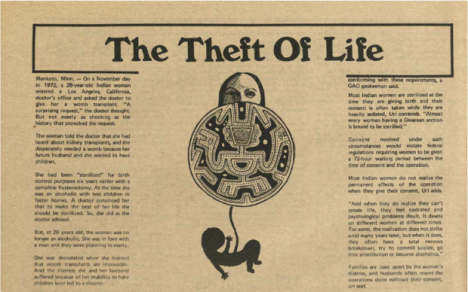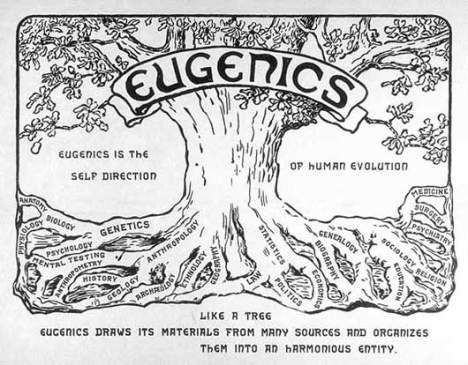In the 1960s and 1970s, the Indian Health Service (IHS) and collaborating physicians performed sterilizations on Native American women, in many cases without the informed consent of their patients. In some cases, women were misled into believing that the sterilization procedure was reversible. In other cases, sterilization was performed without the adequate understanding and consent of the patient, including cases in which the procedure was performed on minors as young as 11 years old.
On this day in history, US General Accountability Office (GAO) investigation found that four Indian Health Service areas were noncompliant with IHS policies regulating consent to sterilization. Four of the 12 Indian Health Service regions sterilized 3,406 American Indian women without their permission between 1973 and 1976. Moreover, 36 of the women were under age 21 despite a court-ordered moratorium on sterilizations of women younger than 21.

The Akwesasne Notes, a newspaper published by the Mohawk Nation, features an article on Dr Connie Redbird Pinkerman-Uri’s investigation into involuntary sterilizations by the IHS. Image from Akwesasne Notes (1977: Vol. 9, No. 4), courtesy of The American Indian Digital History Archive
Inadequate consent forms were a recurring problem; the most common form did not record whether the elements of informed consent had been presented to the patient or what they were told prior to obtaining consent, and physician misunderstanding of IHS regulations was widespread. Forced and coercive sterilizations were carried out by doctors threatening to have patients’ children put into the foster care system if they did not have the procedure, telling patients that hysterectomies were reversible, doing the surgery without approval, convincing patients that their welfare benefits would be taken away, and saying they would die if they did not have the procedure.
As just one documented example, in the 1970s, Jean Whitehorse, a member of the Navajo Nation, went to a hospital in New Mexico for acute appendicitis. Years later, she found out the procedure performed was not just an appendectomy – she had been sterilized via tubal ligation.
The story of sterilization of Native women is a history that has been overlooked for far too long, explained Charon Asetoyer, member of the Comanche Nation and director of the Native American Women’s Health Education Resource Center (NAWHERC) in South Dakota. “The long-term effects of the sterilization practices at the Indian Health Service are devastating to our communities. Women were ashamed when the power to give life was stripped from them. Women are considered sacred in Native cultures; they are the life givers. Many women drank themselves to death when they learned that IHS had sterilized them,” said Asetoyer.
The practice was not limited to Native American women. Doctors were known to recommend for and even practice sterilization on poor and minority women in cases where they would not have done so to a wealthier white patient. Other cases of abuse have been documented as well, including when health providers did not tell women they were going to be sterilized, or other forms of coercion including threatening to take away their welfare or healthcare.
In the South, the practice of administering sterilizations to women of color without consent and frequently without their knowledge was so common it was called “The Mississippi Appendectomy.” As Dorothy Roberts documents in Killing the Black Body: Race, Reproduction, and the Meaning of Liberty, teaching hospitals in the South even performed unnecessary hysterectomies on poor black women as practice for their medical residents. And in fact, the U.S. District Court, District of Columbia, stated in the 1974 ruling in Relf v. Weinberger, 372 F.Supp. 1196 (pursuant to affidavits filed) that an estimated 100,000 to 150,000 poor people were sterilized annually under federally-funded programs.

However, as Sally J. Torpy pointed out in “Native American Women and Coerced Sterilization: On the Trail of Tears in the 1970s” (American Indian Culture and Research Journal 24:2, 2000, pp 1-22):
Native American women represented a unique class of victims among the larger population that faced sterilization and abuses of reproductive rights. These women were especially accessible victims due to several unique cultural and societal realities setting them apart from other minorities. Tribal dependence on the federal government through the Indian Health Service (IHS), the Department of Health, Education, and Welfare (HEW),and the Bureau of Indian Affairs (BIA) robbed them of their children and jeopardized their future as sovereign nations.”
Coercive and involuntary sterilization has now been recognized as a crime against humanity and condemned by a variety of international organizations.
Filed under: legal | Tagged: History, Native American, women |




Leave a comment